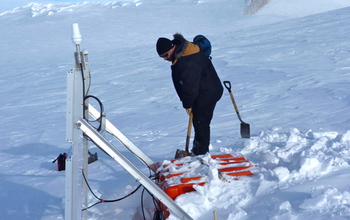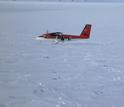News Release 13-192
Early-career investigator discovers current volcanic activity under West Antarctica
Seismic "swarms" indicate active magma moving below critical area of Antarctica's ice sheet

Digging out a seismographic instrument in Antarctica.
November 20, 2013
This material is available primarily for archival purposes. Telephone numbers or other contact information may be out of date; please see current contact information at media contacts.
Scientists funded by the National Science Foundation (NSF) have observed "swarms" of seismic activity--thousands of events in the same locations, sometimes dozens in a single day--between January 2010 and March 2011, indicating current volcanic activity under the massive West Antarctic Ice Sheet (WAIS).
Previous studies using aerial radar and magnetic data detected the presence of subglacial volcanoes in West Antarctica, but without visible eruptions or seismic instruments recording data, the activity status of those systems ranged from extinct to unknown. However, as Amanda Lough, a doctoral candidate at Washington University in St. Louis, points out, "Just because we can't see ...below the ice, doesn't mean there's not something going on there."
"This [study] is saying that we have seismicity, which means [this system] is active right now," according to Lough. "This is saying that the magmatic chamber is still alive; that there is magma that is moving around in the crust."
Lough published her discovery in this week's issue of Nature Geoscience along with her advisor Douglas Wiens, a professor of earth and planetary sciences at Washington University in St. Louis, and a team of co-authors.
NSF has a presidential mandate to manage the U.S. Antarctic Program, through which it coordinates all U.S. science on the Southernmost continent and in the Southern Ocean and the logistical support which makes the science possible.
The characteristics of the seismic events, including the 25- to 40-kilometer (15- to 25-mile) depth at which they occurred, the low frequency of the seismic waves, and the swarm-like behavior rule out glacial and tectonic sources, but are typical of deep long-period earthquakes. Deep long-period earthquakes indicate active magma moving within the Earth's crust and are most often associated with volcanic activity.
The two swarms of seismic activity were detected by instruments deployed to obtain data on the behavior of the WAIS as part of the NSF-funded POLENET project, a global network of GPS and seismic stations. Wiens is a POLENET principal investigator.
Lough plotted the location of the swarms and realized their proximity to the Executive Committee Range, a cluster of volcanoes that were believed to be dormant, in Marie Byrd Land. She consulted with a volcanic seismologist to confirm that the frequency content and the waveforms of the seismic signals were indicative of a volcanic system.
The location of the current seismicity, about 55-60 kilometers (34-37 miles) south of Mt. Sidley, is where current volcanic activity would be predicted to occur based on the geographic locations and the ages of the lava of the known volcanoes in the Executive Committee Range. The seismic swarms were also located near a subglacial high-point of elevation and magnetic anomalies which are both indicative of a volcano.
In some volcanic systems, deep long period earthquakes can indicate an imminent eruption, but Lough sent samples of her data to volcano seismologists who "didn't see seismic events that would occur during an eruption." However, the elevation in bed topography did indicate to Lough and her colleagues that this newly discovered volcano had erupted in the past.
Radar data showed an ash layer trapped within the ice directly above the area of seismic and magmatic activity. Lough initially thought that the ash layer might have evidence of a past eruption from the volcano detected in this study, but based on the distribution of the materials and the prevailing winds, the ash most likely came from an eruption of nearby Mt. Waesche about 8000 years ago. The dating of the ash layer did confirm that Mt. Waesche, believed to have last been active around 100,000 years ago, erupted much more recently than previously thought.
Only an extremely powerful eruption from the active magmatic complex discovered in this study would break through the 1- to 1.5-kilometer (0.6-0.9 miles) thick ice sheet overlying the area, but this research extends the range of active volcanism deeper into the interior of the WAIS than previously known. Should an eruption occur at this location, the short-term increase in heat could cause additional melting of the bottom of the ice sheet, thereby increasing the bed lubrication and hastening ice loss from WAIS.
-NSF-
-
A Twin Otter aircraft used to deploy sensors.
Credit and Larger Version
Media Contacts
Peter West, NSF, (703) 292-7530, email: pwest@nsf.gov
Principal Investigators
Douglas Wiens, Washington University, (314) 935-6517, email: doug@wustl.edu
Amanda Lough, Washington University, (314) 935-8152, email: alough@levee.wustl.edu
The U.S. National Science Foundation propels the nation forward by advancing fundamental research in all fields of science and engineering. NSF supports research and people by providing facilities, instruments and funding to support their ingenuity and sustain the U.S. as a global leader in research and innovation. With a fiscal year 2023 budget of $9.5 billion, NSF funds reach all 50 states through grants to nearly 2,000 colleges, universities and institutions. Each year, NSF receives more than 40,000 competitive proposals and makes about 11,000 new awards. Those awards include support for cooperative research with industry, Arctic and Antarctic research and operations, and U.S. participation in international scientific efforts.
Connect with us online
NSF website: nsf.gov
NSF News: nsf.gov/news
For News Media: nsf.gov/news/newsroom
Statistics: nsf.gov/statistics/
Awards database: nsf.gov/awardsearch/
Follow us on social
Twitter: twitter.com/NSF
Facebook: facebook.com/US.NSF
Instagram: instagram.com/nsfgov

